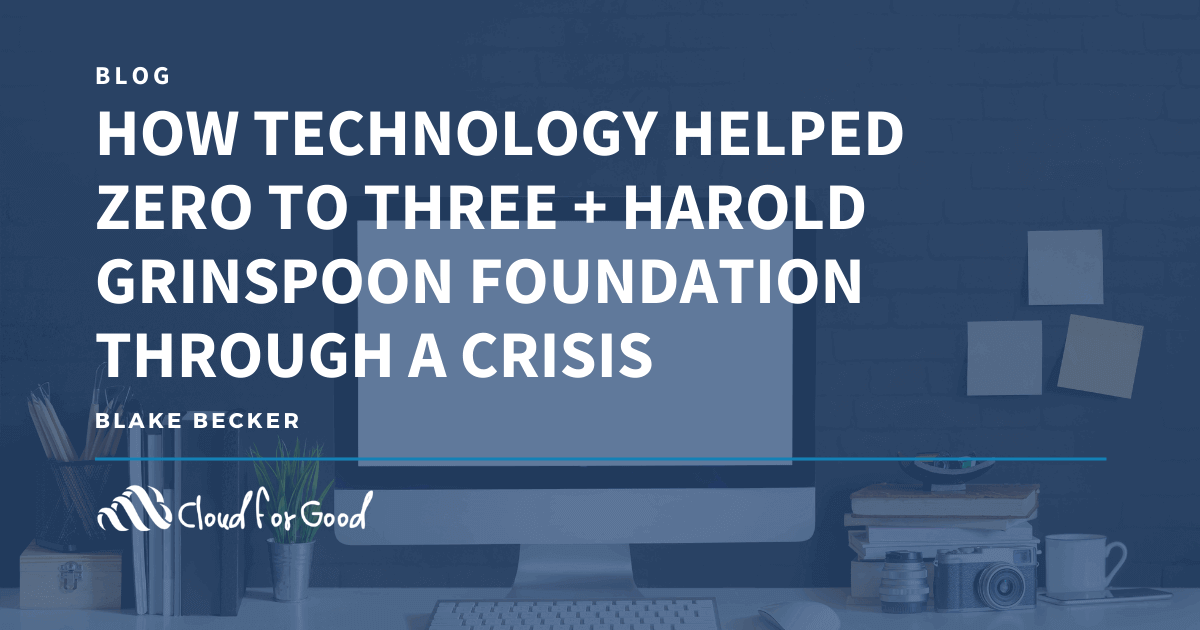During the recent 2021 Nonprofit Technology Conference, Cloud for Good Founder and CEO Tal Frankfurt met virtually with two pioneering leaders utilizing Salesforce to innovate in the nonprofit space during COVID-19: Zero to Three Chief Technology Officer Edima Elinewinga and Harold Grinspoon Foundation Chief Information Officer Eric Jordan. This in-depth roundtable discussion focused on how these organizations have navigated the tectonic technological terrain created by the global pandemic, and what life will, or should, look like for nonprofits post-pandemic.
Cloud for Good has operated as a virtually distributed workforce since day one, delivering solutions remotely for over a decade. The pandemic has created the need for new conversations, new solutions to be implemented that ensure the safety of employees and constituents while preserving the missions of nonprofit operations. Organizations like Harold Grinspoon Foundation and Zero to Three are helping lead the nonprofit sector into a brave new world through Salesforce and remote technologies.
Harold Grinspoon Foundation’s Crisis Challenges + Shifts
Harold Grinspoon Foundation is a collection of programs with the mission of making Jewish life and the Jewish community more connected. As a proven strategic technology executive with 25 years of experience in IT, Eric Jordan found himself unexpectedly prepared for the new task at hand. “The abrupt shift happened almost overnight for Harold Grinspoon Foundation and we had to shift very quickly,” said Jordan, “my president said to me at 4:45 PM on a Friday that I need to accommodate for 100 people in our workforce to be able to connect and continue their work remotely on Monday. We had to completely rethink what it is we do for our community.”
Luckily, Jordan and Harold Grinspoon Foundation were able to execute a plan they already had in place in case of emergency, even though the plan wasn’t formed with a global pandemic in mind. “We’re located in the northeast, so we have blizzards, hurricanes…our office was actually taken out by a tornado at one point.” Jordan and his team took steps to ensure all employees had the ability to work from home and to make sure the foundation’s services remained available online on a global scale to subscribers. This meant empowering VPN connections and moving services onto the cloud to ensure all facets of the organization were made available, securely, to employees from their homes.
Harold Grinspoon Foundation organizes many programs, including summer camp funding, facilitating end-of-life giving, and distributing over half a million educational books a month across 32 countries through the PJ Library. Time was of the essence to respond to the challenges swiftly and remain an invaluable asset to the Jewish community online. “Truth be told, I was planning for a blizzard and not a pandemic, but it was what it was and it really gave us that opportunity to flip the switch overnight. Most innovation happens when you least expect it,” Jordan reflected.
Zero to Three’s Crisis Challenges + Shifts
“Some of our challenges brought opportunities for us as well,” added Elinewinga. As a nonprofit organization that advocates for the care of all children, from birth to the age of three, by supporting the educators and communities that impact them and their development, time was of the essence for Zero to Three to pivot quickly. “In addition to moving everyone to remote work, we saw an increase in the need for advocacy and education to ensure that babies, caregivers, and families were prioritized by congress as they were talking about the pandemic and passing bills.” Families and caregivers were concerned with how the pandemic might affect them. When would daycares reopen? How would the many active programs and initiatives of the organization need to adjust to the new challenges?
“Our organization had to really jump into providing these resources and being that sounding board in congress as an advocate for the families and babies, ensuring congress’ agenda prioritized those we serve,” said Elinewinga. In conjunction with the organization’s political advocacy, Zero to Three transitioned their events to the virtual environment. Doing so allowed newfound flexibility and ability to have congresspeople speak, virtually, to the issues families were most concerned with.
Zero to Three’s Annual Conference even drew its largest crowd in the organization’s history in part by its virtual nature. “The pandemic helped us to accelerate our technology innovation and receive buy-in from our people. Fundraising actually increased last year; moving to Salesforce from our previous CRM provided a system of record that was able to achieve higher visibility of our constituents and empower our fundraising efforts,” summarized Elinewinga.
The Impact on Nonprofits Post-Pandemic
So, where do we go from here? If Zero to Three and Harold Grinspoon Foundation’s application of Salesforce and virtual technologies are any indications, we’re headed towards a more technologically enlightened time. “Being able to witness an entire world continue the business of life online was simply awe-inspiring…you can’t unring that bell. This has been an accelerant in the technology space, especially in the collaboration space,” proclaimed Jordan. Elinewinga agreed, saying, “I don’t think we’re going back to the old normal. We will have a new normal going forward and that new normal will be a balance of providing flexibility to work remotely and better support our constituents.”
With so many people working, learning, and living during at-home orders, technology has become even more critical to the maintaining of collaboration, community, and operations in nonprofit organizations. As more and more people are becoming vaccinated, a sense of hope and rebirth has sprung in early 2021. While we’re not quite out of the woods yet, the optimism and endurance of our society have reflected into the nonprofit sector, where organizations are banding together for the greater good. Each day brings us closer to a new, perhaps improved, normal, where lessons learned are helping build a better outlook in a post-pandemic world.





